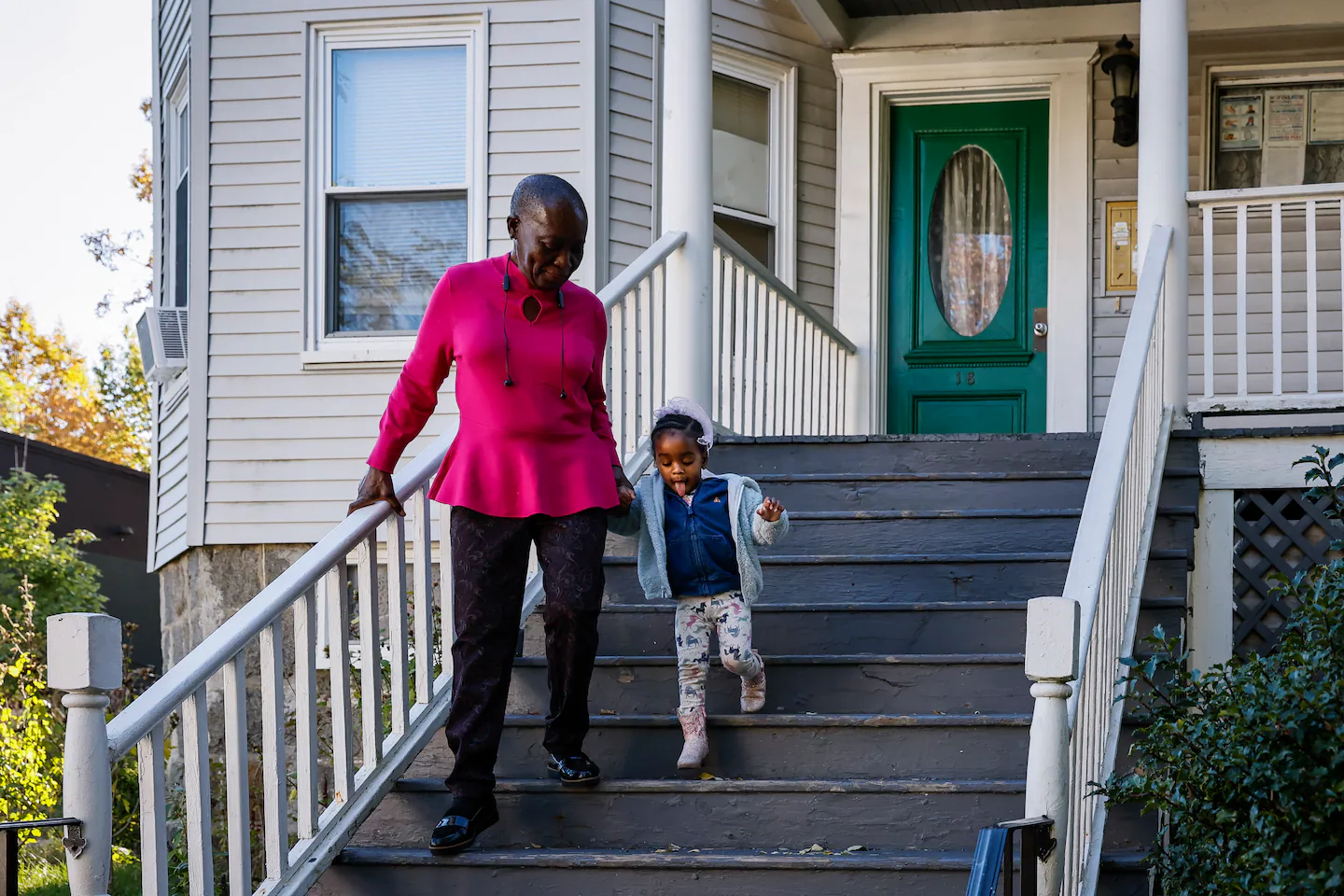Copyright The Boston Globe

Greenaway purchased her 4,700-square-foot triple-decker in 1997 on a child care provider’s salary. It’s everything to her family: a home, a place of business for three generations, and a source of rental income. It’s also an investment now worth roughly $1.2 million, more than seven times what Greenaway paid for it. “I have abundance,” Greenaway said, pointing to a child’s drawing of an overflowing pot of gold at the end of the rainbow. “I don’t have a whole lot, but I have sunshine and I have gold.” But for Greenaway’s daughter and granddaughter, who followed her into a career that once provided a stable way of life, the hope for upward mobility in early education — or even a secure living — has dimmed considerably. In the past, jobs that often didn’t require a college degree could keep families housed and fed for generations. That’s not always the case anymore. A third-generation Boston school bus driver can barely afford to live here since his divorce, even though his mother got by with the same work. A Gloucester fisherman whose line of work goes back to his great-great-grandfather in Sicily doesn’t want his son to struggle with the industry’s increasing regulations and expenses. In Andover, mother and daughter paraprofessionals — an occupation in which real-wage salaries peaked in the 1970s — saw their wages rise after a 2023 strike, but to just $38,000 a year. For these families, as with the Greenaways, working the same job, in the same city, just doesn’t add up to a solid middle-class life like it used to. Greenaway’s granddaughter, 29-year-old Nacaira Tse Greenaway, who drew that hopeful pot of gold picture years ago, is facing a less bountiful future. She marvels that her grandmother was able to buy a triple-decker on her own as a single mother working in child care. When she tried to find a place of her own a few years ago, all the apartments she looked at were around $3,000 a month, roughly the same amount she was making as a freelance illustrator. So instead, she decided to rent out the basement apartment in her grandfather’s Mattapan home. After working as a child-care assistant for her grandmother and her mother, who ran her own day care on the second floor of Greenaway’s triple-decker, Tse Greenaway saw the growing divide between the money child-care providers make and the soaring cost of living. So she got a bachelor’s degree at Lesley University, and then spent a year trying to find an illustration job before finally taking one as a union child-care coordinator. It paid more, but still not enough to afford life in Boston. “There’s just so many things that make me uneasy,” she said. “I have a stable job, but the only thing I’m thinking of the future is: What is my Plan B if this doesn’t work out?” *** Mary Greenaway was 22 in 1980, when she moved to Dorchester from the Caribbean island of Montserrat with her 2-year-old daughter, Danette. They were joining Danette’s father, who’d arrived a few years earlier and landed a good job on the assembly line at the defense contractor Raytheon. His paycheck let them save most of the money Greenaway made working in medical billing. The couple bought a two-family home in Mattapan, and when her first granddaughter, Nacaira, was born, Greenaway started a child-care business. After she divorced her husband, she still had enough money in the bank to put down $15,000 for a $165,000 triple-decker in Dorchester. Greenaway still lives on the first floor of that home. For years, her oldest daughter ran her own day care in her home on the second floor, before closing it during the pandemic and moving into real estate. Another daughter lived on the third level for several years. Tse Greenaway can’t imagine ever being able to afford a home of her own in Greater Boston, where the median sale price of a single-family home hit $1 million in July — almost double what it was just nine years ago, though it has come down slightly since. Even when it comes to buying home furnishings, she’s careful about every dollar. On a warm Saturday morning in August, right after her paycheck hit her bank account, Tse Greenaway traveled across the city on public transportation in search of a new comforter for her bed. After taking three train lines to three stores, and spending four hours comparison shopping, she found one for $60 — roughly half what it costs online. She didn’t pull out her wallet for anything else, not even a snack in the checkout line. “You never know,” she said. “I don’t want to overspend and then not be able to take care of myself.” Even keeping to a strict budget, she is finding that coming up with the tens of thousands of dollars it would cost for a down payment on a house seems like an impossible stretch. A typical house in Greater Boston costs more than six times the average annual household income, according to Harvard’s Joint Center for Housing Studies — double the ratio economists consider healthy, as it was in the 1980s. Mary Greenaway’s ability to buy a house in 1997 had a huge ripple effect on the economic security of her family. It helped propel her three daughters — all licensed child-care providers themselves — into much better positions, providing an affordable place to stay while they saved money for college and homes of their own. The youngest, Dominique, a social worker, lives in Mattapan; Danielle, a nurse, bought a house across the street; and the eldest, Danette Juba, the daughter who became a real estate agent, is in Randolph. Juba recently started a job as a preschool director at a Quincy child-care center and is grateful for the steady paycheck and benefits. “For the first time in my adult life, I can actually breathe,” she said. “When it’s great, it’s gravy,” Greenaway said of the family business. But lately, it’s been neither. And wages that no longer provide a sense of financial security — for Greenaway as well as for the parents of the children she cares for — are a huge part of the reason. “Over the past generation or more now, jobs that don’t require a college education have suffered some of the worst wage stagnation than we’ve seen anywhere,” said Joe McCartin, a labor historian who runs Georgetown University’s Kalmanovitz Initiative for Labor and the Working Poor in Washington, D.C. “We have dramatically moved in the direction of radical inequality at levels we haven’t seen since before the Great Depression.” Dietrich Jones, a Boston school bus driver for 37 years, has felt the effects of this downward pressure. His mother raised three sons driving a bus, first for the schools and then the MBTA; his grandmother started driving in her 60s after raising seven kids on her husband’s union carpentry salary. Jones had a “fantastic life” when he and his high school sweetheart were together, sharing parenting duties and financial obligations. Then they got divorced and sold their house. Now Jones, 57, lives in an apartment in Roslindale and doubts he’ll ever be a homeowner again. “I’ve lived in this city all my life and I can barely afford to live here,” he said. Fifth-generation fisherman Tommy Testaverde Jr., who lives in Gloucester, used to think his son, now 11, would carry on the family business that allowed Testaverde to buy a house and support his family. “Everything comes from the boat,” he said. But as regulations increase and expenses rise, and fish prices remain the same, he’s steering his son away from fishing, maybe toward a more sustainable job on the water in the Coast Guard or Navy. Paraprofessionals, who provide classroom assistance for students in need, have also suffered. Holly Currier, who works alongside her mother at Andover High School, wasn’t planning to stay in the profession long. But she got active in the union and helped push for higher wages, which have nearly doubled since 2019. After decades of inflation-related erosion, these types of gains are happening around the country, bringing salaries up to the equivalent of what unionized paraprofessionals were making 50 years ago, according to Nick Juravich, a labor professor at the University of Massachusetts Boston and author of “Para Power.” Currier, 33, is getting a master’s and could move into a higher-paying profession — although she wants to stay put and keep fighting for better working conditions — but her mother’s options are limited: “She is very much stuck,” Currier said. Much of this reduced mobility is related to the growing power imbalance between employers and workers, McCartin said. Union numbers have declined — falling from more than 20 percent of all US workers in union jobs in 1983 to less than 10 percent today — and private equity money has made “maximizing shareholder value” a corporate mantra. As a result, many working people lost their bargaining power. About 2.2 million people work in early education in the United States — roughly half of them women of color, including many immigrants – according to the Center for the Study of Child Care Employment at the University of California Berkeley. Sectors that employ large numbers of immigrant women, who are less likely to have formal education or legal status, have some of the largest disparities between wages and the rising cost of living, said Katherine Newman, a sociology and public policy professor at the University of California Berkeley who has written about middle-class economic insecurity. In Massachusetts, more than a quarter of the state’s 46,000 early childhood educators were born in another country. “They’re the most unprotected, especially now,” Newman said, alluding to the Trump administration’s crackdown on immigrants. Wages for child care workers in Massachusetts have risen 14 percent over the past 20 years, accounting for inflation, but those increases haven’t been enough to maintain a comfortable lifestyle. Today, early educators aretwice as likely to live in poverty as the average worker in the Commonwealth. It used to be fairly common for multiple generations to run family child-care businesses, said Peggy Haack, an early education advocate and historian: “It is in their home,” she said. “That is what they’ve grown up knowing.” But it hasn’t been the same since the astronomical rise in the cost of housing following the 2008 recession. “The younger generation, they can’t do it,” Haack said. *** Mary Greenaway starts most days by preparing breakfast for the kids, maybe eggs or oatmeal with fruit. They have a music lesson, do arts and crafts, and play outside if the weather is nice. That’s followed by lunch, often something like spaghetti, salad, and milk. The meals are especially important to the children she has cared for over the years who were homeless or in the foster care system. Greenaway has only been caring for her four grandchildren lately. It has been difficult to fill her slots lately because the wait list for the state’s child-care voucher program has been frozen since early 2024 due to soaring demand in a state where child-care costs are among the highest in the country. Poor families who rely on these state subsidies often use more affordable home-based providers like Greenaway. But if parents don’t get financial assistance, they can’t send their kids to day care. “Right now, the business is slow,” Greenaway said. Greenaway’s daughters don’t pay for their children’s care, but they contribute to their mother’s expenses. She also just started collecting Social Security. But retirement isn’t in the cards just yet. In five years, her house will be paid off and her grandkids will be in school. Maybe then she’ll think about winding down. *** Tse Greenaway lives with three cats named for “Hello Kitty” characters in her Mattapan apartment — the same spot her grandmother launched her child-care business three decades ago. After spending eight years as a certified assistant in her mother’s and grandmother’s child-care facilities, Tse Greenaway decided to step away from the family business, although she still helps her grandmother from time to time. She wanted health insurance; a job with steady pay that didn’t rise and fall with the number of kids enrolled; and the ability to take a sick day without having to scramble to find someone to cover for her. Her current job is still very much tied to child care, now focused on legislation and policy to get at the root of problems in the industry. Currently, she’s part of a team working to pass a bill that would raise the state voucher pay for informal caregivers, who currently make between $9 and $25 a day to watch a child of a friend, relative, or neighbor. For Tse Greenaway, the days can blend together. Get home from a long day of work, clean out the litter box, heat up leftovers for dinner, maybe lay on the couch and scroll TikTok videos for awhile. “Then rinse and repeat,” she said. She knows she’s lucky to have the solid foundation her mother and grandmother provided. But she still worries about building a future in Boston, near most of her family. She dreams of one day working as an illustrator, along with her child-care advocacy work, making enough to build her life and move out of her grandfather’s basement. But planning that far ahead seems impossible, Tse Greenaway said. “It’s hard enough for me to imagine tomorrow.” Photos by Erin Clark.



